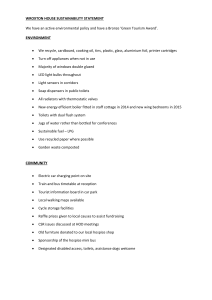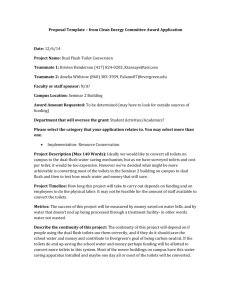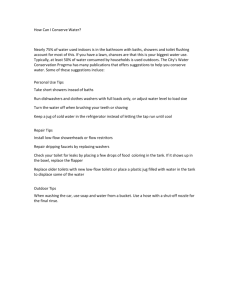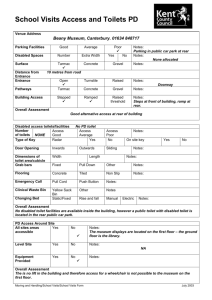Changing Places presentation for advocates
advertisement
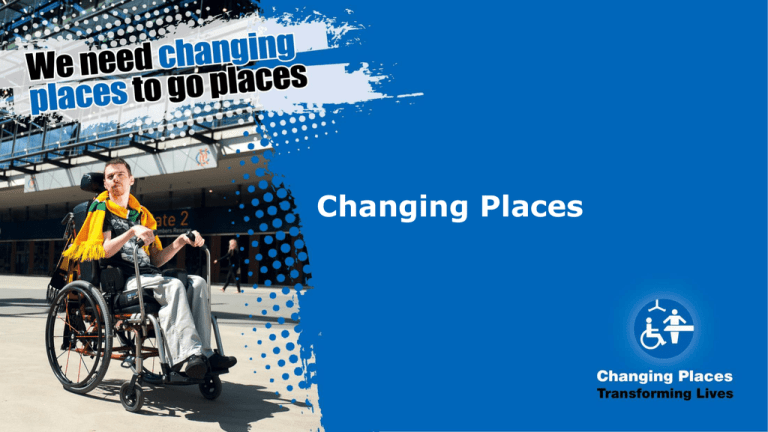
Changing Places Table of content The problem The solution The Changing Places campaign How you can assist THE PROBLEM - A LIFE WITHOUT TOILETS How many people are affected • • • • • In 2009, around 195,800 people with a disability used continence aids with a large number of these requiring complete assistance to use the toilet (Incontinence in Australia, AIHW) – this is significantly more than the population of Darwin A large number of these are unable to use regular accessible public toilets and require specialist equipment, such as a hoist and adult sized change table This may include people with an ABI, cerebral palsy, MS, spina bifida, motor neurone disease etc. There are less than 30 public toilets with these facilities throughout Australia Australia’s ageing population means the problem will only get worse… Impacts on PWDs • Major barrier to social inclusion • Limitations on where one can go and how long one can go for • Change facilities can influence travel and leisure options as well as providing barriers to professional life “Employment opportunities are almost nonexistent without toilets to meet my needs – there is a no lifting policy for support staff so I’ve had to leave meetings halfway through to avoid sitting in soiled pads” – Liz Ellis, 29 years old, BA Social Work Impacts on carers • Carers faced with choice to put their family members/clients in undignified situations or not venture far from home • Risk of injury from lifting • Professional carers unable to take their clients out due to no lifting policy • Planning day around toilets – affects the whole family • People in regional areas more affected “Most people have seen the stories of how many germs a handbag can carry from being put on the floor of a toilet, so can you then imagine lying on the floor of a public toilet yourself? Michael is exposed to this whenever he needs to be changed and we are out for the day.” - Debby Conlon, mother of Michael (17 years old) Tell your story INSERT YOUR OWN STORY OR DELETE SLIDE THE SOLUTION CHANGING PLACES • Changing Places toilets commenced in the UK in 2006. • There are now over 700 Changing Place toilets located in shopping centers, tourist attractions, airports and other major public spaces in the UK • Each Changing Places toilet provides: a height adjustable adult-sized changing bench a tracking hoist system safe and clean environment enough space • Usually accessible with an MLAK key Key Features •Additional grabrails •A centrally placed toilet •Room coverage hoist system •Adjustable height change bench •Washbasin & integrated shelf •Waste bin •Disposable change bench cover dispenser •Automatic door •Hand dryer Introducing the Marveloo • • • • Mobile Changing Place facility Two managed by Maroondah Council Portable on flatbed truck Available for hire for events/conferences around Melbourne metro area • AUD 1,700 plus GST for duration of event – cost includes transportation and consumables (toilet paper, wipes etc.) • Users must bring their own sling • http://www.maroondah.vic.gov.au/Marveloo.aspx Adult change facilities and Changing places in Victoria Full listing downloadable here THE CHANGING PLACES CAMPAIGN CHANGING PLACES TRANSFORMING LIVES Changing Places campaign Changing Places toilets should be provided in addition to standard accessible toilets National campaign for fully accessible public toilets in: • shopping centres • premium train stations • aquatic facilities • major sporting and recreational complexes • major cultural facilities • airports • hospitals . Changing Places website •A map with all the locations of Changing Places toilets • Changing Places information kit for grassroots campaigners • Videos for download • Materials for campaigners • Schematics and cost info for builders • Current local campaign you can join • Case studies and stories www.changingplaces.org.au Changing Places advocates • Changing Place advocates are individuals and groups who support the Changing Places projects by raising awareness of the need for fully accessible public toilets in their community • They operate in ways which suit their situation and skill set. Some activities include: - Writing emails to shopping centres, major developers, politicians etc. to request a Changing Place facility - Forming groups of likeminded advocates in their local community and arranging meetings with the local council - Participating in media and awareness activities e.g. sharing their story with newspaper, TV and radio interviews - Promoting Changing Places through their personal and professional networks - Starting online petitions to raise awareness and advocate for change - Representing Changing Places at exhibitions, presentations, student talks etc. What you can do to help • Follow the Changing Places Facebook and Twitter channels: www.facebook.com/ChangingPlacesAustralia @ChangingPlaceAU • Join the Changing Places mailing list • Become a Changing Places advocate – email info@changingplaces.org.au for further info • Distribute Changing Places awareness materials to clients and professional contacts • Use the Changing Places location map • Donate to the Changing Places project – further info at www.changingplaces.org.au • Inform us of any new major infrastructure developments in your community (shopping centres, stadiums etc.) Victorian government support • • • • • September 2014, Victorian government announced funding for six fixed Changing Places and one mobile changing facility Three placed at MCG, Melbourne Zoo and Rod Laver Arena Three to be decided in consultation with the Victorian public Online poll on Changing Places website resulted in over 300 votes in one week Most popular locations so far shopping centres, parks and gardens and sporting and entertainment facilities Changing Places at Ringwood Lakes Officially opened 1st October 2014 • Located close to playground which includes a liberty swing • Convenient location off highway for access by travellers • Accessible by Mlak key holders – extra keys held at customer service centres • Check out the video in The Age Media coverage Quote “I have to lay him down on dirty public toilet floors with his head under the pan where someone else has just peed. I don’t like putting my handbag down on some floors; why on earth should I be expected to lie my precious son on them” Moving into the 21st Century •1775 - The first patent for the flushing water closet was issued to Alexander Cummings. 1852 first public toilet (flushing). •Since then technology and human rights has enormous advances •In the meantime in 2013 we have people with a disability and their families still waiting for their first toilet in their local community •Changing Places for a moment, imagine a community for you without toilets
